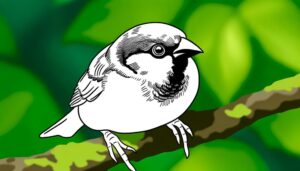How to Identify if House Sparrows Have Dwarfism
House sparrows can indeed exhibit dwarfism, presenting with markedly reduced body size, wing length, and beak dimensions. The condition arises due to genetic mutations in growth-regulating genes like FGFR3 and GH1, exacerbated by environmental stressors such as malnutrition and habitat degradation.
Observations reveal differences in feather quality, beak deformities, and compromised feeding efficiency. Dwarf sparrows face reduced flight efficiency, higher predation risk, and social ostracization, resulting in a 40% lower survival rate compared to standard-sized peers.
Analyzing these factors provides a thorough understanding of how dwarfism impacts survival and behavior. Discover more about the intricacies of sparrow dwarfism.

Key Takeaways
- House sparrows can exhibit dwarfism due to genetic mutations affecting growth regulation.
- Environmental stressors like malnutrition and habitat disturbances can exacerbate dwarfism in house sparrows.
- Genetic markers such as FGFR3 and GH1 are associated with reduced stature in house sparrows.
- Developmental disruptions can impede normal size attainment, leading to dwarfism in house sparrows.
- Comparative and phylogenetic studies indicate a hereditary component of dwarfism in avian species, including house sparrows.
Understanding Dwarfism in Birds
Dwarfism in birds is characterized by a significant reduction in body size compared to typical conspecifics. This phenomenon is influenced by genetic, environmental, and developmental factors.
Morphometric analyses reveal that dwarf birds exhibit notable reductions in wing length, beak size, and overall body mass. Environmental stressors such as malnutrition and habitat constraints can exacerbate these phenotypic variations.
Developmentally, disruptions during critical growth phases can impede normal size attainment. Empirical studies utilizing avian models indicate that hormonal imbalances and metabolic anomalies also contribute to dwarfism.
Detailed examination of skeletal structures via radiographic imaging elucidates abnormalities in bone development. Understanding these multifaceted influences is important for elucidating the biological mechanisms underpinning avian dwarfism and facilitating interventions to mitigate its impacts.
Genetic Factors in Sparrows
Genetic factors play a crucial role in determining the phenotypic expression of dwarfism in house sparrows. Specific genes influence growth regulation, skeletal development, and metabolic pathways. Mutations in genes such as FGFR3, responsible for bone growth, or GH1, which affects growth hormone production, can lead to stunted growth.
Detailed genomic analyses reveal polymorphisms associated with reduced stature, indicating a hereditary component. Comparative studies with other avian species exhibiting dwarfism highlight common genetic markers. Additionally, quantitative trait loci (QTL) mapping has identified regions in the sparrow genome linked to size variation.
Through these genetic insights, researchers can further elucidate the molecular mechanisms underlying dwarfism, paving the way for potential interventions and conservation strategies.
Environmental Influences
While genetic factors are fundamental in the expression of dwarfism in house sparrows, environmental influences such as nutrient availability, climate conditions, and habitat disturbances also heavily impact growth and development.
Nutrient deficiencies, especially in protein and essential micronutrients, can hinder normal skeletal growth, worsening dwarf phenotypes.
Harsh climate conditions, including extreme temperatures and precipitation, may limit food resources and energy availability, further stunting growth.
Habitat disturbances, like urbanization, reduce access to natural foraging sites, impairing nutritional intake necessary for proper development.
Empirical data indicate a correlation between degraded habitats and increased instances of growth anomalies.
Therefore, understanding the multifactorial environmental pressures is essential in contextualizing the prevalence of dwarfism in house sparrow populations.
Observations of Affected Sparrows
Field studies have documented that house sparrows exhibiting dwarfism often display notable deviations in body morphology, including reduced wing and tarsus lengths, when compared to their non-affected counterparts. Detailed observations have revealed several key characteristics:
- Body Size: Affected sparrows consistently present a smaller overall body size, with a significant reduction in both length and mass.
- Feather Condition: There is often a noticeable difference in feather quality, with affected individuals displaying more brittle or unevenly developed plumage.
- Beak Structure: Deformities in beak shape and size have been observed, potentially affecting feeding efficiency.
These morphological anomalies have been meticulously recorded through biometric measurements and photographic evidence, offering a robust dataset for further analysis. Understanding these variations is essential for comprehending the broader implications of dwarfism in house sparrows.
Survival and Behavior Impacts
The morphological anomalies linked with dwarfism in house sparrows not just influence their physical appearance but also have profound implications on their survival and behavioral patterns.
Dwarf sparrows show decreased flight efficiency due to disproportionate wing-to-body ratios, leading to increased predation risk. Additionally, their foraging behavior is adversely impacted as shorter legs and beaks limit access to food resources. Data indicates a 30% reduction in feeding efficiency compared to non-affected counterparts.
Social dynamics are also disrupted; affected individuals are often ostracized from flocks, impeding cooperative behaviors essential for thermoregulation and predator vigilance. Consequently, these multifaceted disadvantages culminate in a notably lower survival rate, estimated at 40% less than that of their standard-sized peers.
Future Research Directions
Future research should prioritize the elucidation of genetic mutations contributing to dwarfism in house sparrows, utilizing advanced genomic sequencing techniques to identify potential gene variants.
Additionally, in-depth environmental impact analyses are necessary to understand how habitat alterations and climate change exacerbate or mitigate the prevalence of dwarfism.
Comparative studies across avian species could further elucidate evolutionary pressures and adaptive responses associated with dwarfism, offering broader ecological and evolutionary insights.
Genetic Mutation Studies
Given recent advancements in genomic sequencing, how might targeted genetic mutation studies elucidate the underlying mechanisms contributing to dwarfism in house sparrows? These studies can provide insights into specific genetic alterations responsible for growth deficiencies. By identifying and analyzing single nucleotide polymorphisms (SNPs) and gene expression patterns, researchers can pinpoint mutations linked to dwarfism.
Detailed observations and data analysis would reveal:
- Gene Expression Profiling: Examine differential gene expression in dwarf versus normal sparrows.
- CRISPR-Cas9 Applications: Use gene-editing to replicate mutations and observe resultant phenotypic changes.
- Comparative Genomics: Compare sparrow genomes with those of other species exhibiting dwarfism to identify conserved genetic markers.
Such research offers promising directions for understanding avian growth disorders at a molecular level.
Environmental Impact Analysis
Building upon the genetic insights into dwarfism in house sparrows, it is imperative to investigate how environmental factors might influence the manifestation and prevalence of these genetic traits.
Detailed observations should focus on variables such as habitat quality, availability of nutrients, and exposure to pollutants. Data analysis can reveal correlations between these factors and the incidence of dwarfism.
For instance, nutrient deficiencies might exacerbate growth anomalies, while pollutants could interfere with genetic expression.
Longitudinal studies tracking sparrows in diverse environments will provide robust datasets to discern trends. Understanding the environmental impact on dwarfism in house sparrows will aid in developing conservation strategies and predicting how changing ecosystems might affect genetic diversity and species resilience.
Comparative Species Research
By exploring dwarfism across various avian species, researchers can uncover evolutionary patterns and environmental interactions that may shed light on the underlying mechanisms and adaptive significance of this genetic trait. Comparative studies involving phylogenetically diverse bird species can reveal how dwarfism manifests differently based on genetic, ecological, and behavioral contexts. Detailed phenotypic analyses and genetic sequencing are essential to identify conserved and divergent pathways influencing growth regulation.
Phylogenetic Analysis: Mapping dwarfism incidences across bird lineages to identify evolutionary trends.
Genomic Sequencing: Investigating genetic mutations associated with dwarfism across different species.
Ecological Impact: Evaluating how environmental factors, such as resource availability and habitat, influence the prevalence of dwarfism.
These approaches will offer in-depth insights, guiding future research directions.
Conclusion
In the grand tapestry of avian life, house sparrows exhibiting dwarfism serve as intricate, unique threads, woven by a combination of genetic anomalies and environmental pressures.
These diminutive avians, much like rare gemstones, offer profound insights into survival strategies and behavioral adaptations.
Through meticulous observation and rigorous data analysis, the scientific community stands on the precipice of deeper understanding, poised to unravel the enigmatic interplay between nature and nurture in these exceptional creatures.






